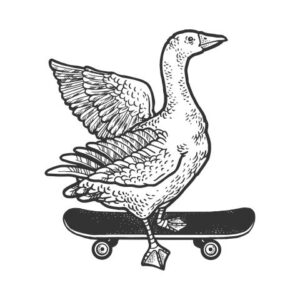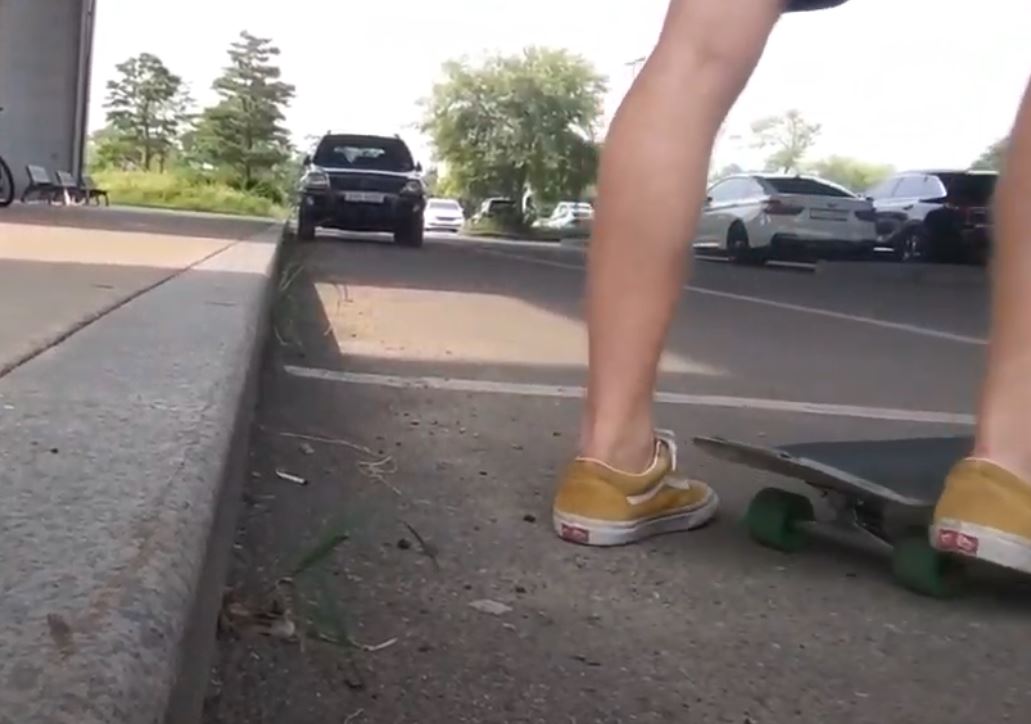There comes a time in the lives of every parking lot skater where they are pushed towards the path of greatness. Destiny beckons and he or she attempts to skate the curb. Yet, so many hopes and dreams of would-be skaters are crushed by the merciless and infamous curb.
I’m being dramatic, but skating a curb is pretty much the first obstacle any skater will go for whether they can ollie or not. I’m going to go over three basic maneuvers: ride ff the curb, ollie up the curb, and ollie off the curb.
There is way more you can do with a curb like stalls and slappy grinds, but this is a beginner guide and I’m really just going to focus on the absolute basics.
So let’s get straight into it.
How to Ride Off a Curb
You don’t need an ollie to ride off of the curb and I remember learning to do this with my friends at 12 and then challenging each other to ride down a 3-stair with the same technique.
To ride off of a curb, keep your back foot on the tail of the board and use this back foot to keep the board level as you come off of the curb. The motion will be similar to a kick turn where you slightly bring the front of your board up. Stay centered above your board as you come off the curb and land with your weight evenly distributed or with slightly more weight on your back foot.
This sounds complicated to write, but the motion is rather simple. I suggest you bring your board up just slightly like a kick turn motion, but without the turning part. This will bring your board up so that it stays with your feet rather than falling beneath you. The difference in board control and how the landing feels is night and day.
You can do this off any size ledge really, but starting with a curb is a good idea. This is something that you will literally learn in an afternoon if you’re persistent. It’s a good placeholder for learning to ollie off of a curb or ledge and is how you’ll exit grinds much later on.
Dedicate an afternoon to simply riding off a curb smoothly and confidently. Don’t go too slow. You’ll need some speed to ride away smoothly.
How To Ollie Up a Curb
If you can ollie, there really is nothing new to learn here. If you are struggling with an ollie, you need to go back and make sure you can ollie while moving on flat ground before you try to ollie a curb. Check out my troubleshooting guide for common ollie problems and mistakes here.
To do an ollie up a curb, roll straight towards the curb at a slight angle. Just before the front of the board makes contact with the curb, pop an ollie. Stay centered above your board with your shoulders level and straight. Don’t immediately bring your ollie down so that you have enough air to clear the curb. Land on your board with your weight evenly distributed or with slightly more weight on your back foot.
There is no real secret to doing an ollie onto a curb other than to stay relaxed and centered above the board. When doing an ollie over something or up a curb, it is common for a beginner to attempt to bail out and turn the board or lean away.
Also, try to not immediately slam down your ollie. It won’t take much air to make it up a curb, but it will feel much more satisfying to have a little bit of air time before hitting the pavement again.
It will likely take some time to land this consistently if you are a complete beginner. It took me some time to learn to stay centered on my board and get the timing of when you pop right. If you practice regularly, you should have this down in a week or two.
How To Ollie Off a Curb
Doing an ollie off a curb can be mentally more intimidating than an ollie up a curb. The drop is bigger and you often have no reason to ollie of a curb except to get some air. This is an important skill for later though as you’ll need to ollie of ledges to do most tricks and to safely clear stairs.
To ollie off a curb, ride toward the edge of the curb directly or at a slight angle. Pop your ollie right before the front wheels would come off the curb itself. Stay centered above your board and keep your shoulders straight and level. Don’t try to put your board down immediately and instead simply come down with your board and your legs slightly bent. Land with your weight distributed evenly or just slightly more weight on the back foot.
If you try to put down your ollie off a ledge, you will straighten out your legs early and make a painful and awkward landing. Avoid this now because it will injure you on bigger ledges. You want to keep your knees slightly bent so you can take the landing smoothly.
Other than this, the largest problem for people is just committing. There is more of a mental block with doing an ollie off a curb or ledge than anything else. Your brain is afraid of heights and wants to bail out or turn to face the perceived danger. You will need to practice to overcome this, but generally, it will just take a week or two to be comfortable doing an ollie off a curb or small ledge.
If you’re struggling with turning while you ollie, then check out our guide to doing an ollie straight here.
Tips For Skating Curbs
Learn it for cruising
Learning to skate a curb is an important step in learning to skate other obstacles and learning to ollie down ledges. However, even if you don’t want to learn tricks, learning to skate a curb is perfect for cruising.
There is nothing better than an uninterrupted slow when cruising and being able to confidently ollie up and ride off of curbs on a skateboard makes you feel like you’re really fluidly riding the terrain around you. I hate needing to stop, pick up my board, and put it back down before starting to ride again. Skating a curb while cruising will make you feel and look cooler, and will add so much fun and style to your riding.

Don’t fear the drop
If you can ollie, the only real obstacle you have is mental. Yes, learning to not put down your ollie (straighten your legs to push your board down) will take some time to do naturally for some people, but there really are no new skills you need to learn.
A curb is a tiny drop. Falling will not hurt much more than falling on flat ground. Falling onto the curb itself can definitely hurt you, but that fall is very unlikely if you have your ollies down. Something that can help you is to wear elbow pads and wrist guards while you try doing an ollie off a curb. It will help you have more confidence and will protect you if you do fall. As an adult, it is always a good idea to wear pads.
So yeah. Just commit. Be brave.
Get good control of your ollies
Having a good amount of board control and being comfortable on your board makes a world of difference in the style of your tricks and how quickly you’ll learn to skate curbs.
If you just learned an ollie and haven’t taken the time to cruise and ride your board a lot, then you should give it some time before you try doing ollies off of things. I remember when I started skating again as an adult, I wanted to progress fast. I was impatient and was trying to ollie down some small 3-stair before I could really ollie over anything consistently. I didn’t have good board control and ended up trying to step off of my board and sprained my ankle badly. I lost at least 2 months of skate time to that ankle.
So don’t push yourself too fast. There is no rush. Time will pass anyway and no one will think you’re cool for being able to kickflip. Be patient and ride your board. Get flat ground ollies and ollies on slopes down before you go for the curb. Skating is not a contest.
If you want to know how long it takes to learn an ollie on average, check out our data-driven guide here.
Conclusion
Riding a curb is the first step to skating more complicated obstacles and every beginner will need to start with a curb so I hope this guide helped you. Even if you don’t want to learn tricks and only want to cruise, learning to skate a curb is a ton of fun. You don’t want to stop, pick up your board, set it down, and then keep cruising.
Learning to ollie up and skate down different curbs or ledges will make cruising and street skating way more fun.
Anyway, thanks for reading, and look out for more content from Board and Wheels.


